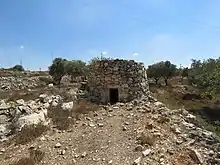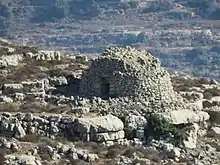Watchtower (agricultural)
An agricultural watchtower (Phoenician name: shomōr; Hebrew: שומרה shomerā; Arabic: قصر qāsr, "a castle") was a type of building in the ancient Middle East for farmers to watch over farmland (usually vineyards) during the harvest period.[1]

The structures usually had two storeys, with a thick-walled lower floor made of untreated stone for storage of the harvest, and an upper floor that functioned as a watchtower.[2] The temperature inside the structure was relatively cool due to the thick wall of the lower floor, allowing the storage of crops such as grapes, which would otherwise start to ferment. During the harvest period, farmworkers or entire families could live in the watchtower rather than return to their home each day.[3]
The Book of Isaiah refers to an agricultural watchtower at Isaiah 5:2:
He dug it and cleared it of stones, and planted it with choice vines; he built a watchtower in the midst of it, and hewed out a wine vat in it; he expected it to yield grapes, but it yielded wild grapes. (Isaiah 5:2)

Remains of watchtowers are found throughout Syria and Palestine, and some are still in use.
References
- Vineyard and Grape Pressing Life in the Holy Land.
- John A. Beck (2011). Zondervan Dictionary of Biblical Imagery. Watchtower. P. 484.
- Baldensperger P. J. The Immovable East // Palestine Exploration Fund Quarterly Statement. 1908, p. 293.
Bibliography
- Conder, C.R.; Kitchener, H.H. (1883). The Survey of Western Palestine: Memoirs of the Topography, Orography, Hydrography, and Archaeology. 3. London: Committee of the Palestine Exploration Fund.
- John A. Beck (2011). Zondervan Dictionary of Biblical Imagery. Watchtower. P. 484.
- Vineyard and Grape Pressing Life in the Holy Land.